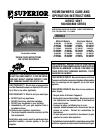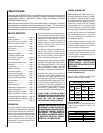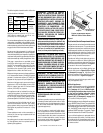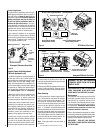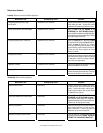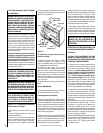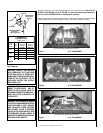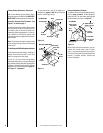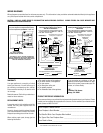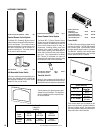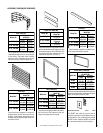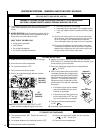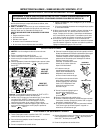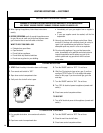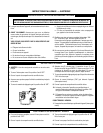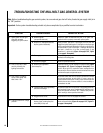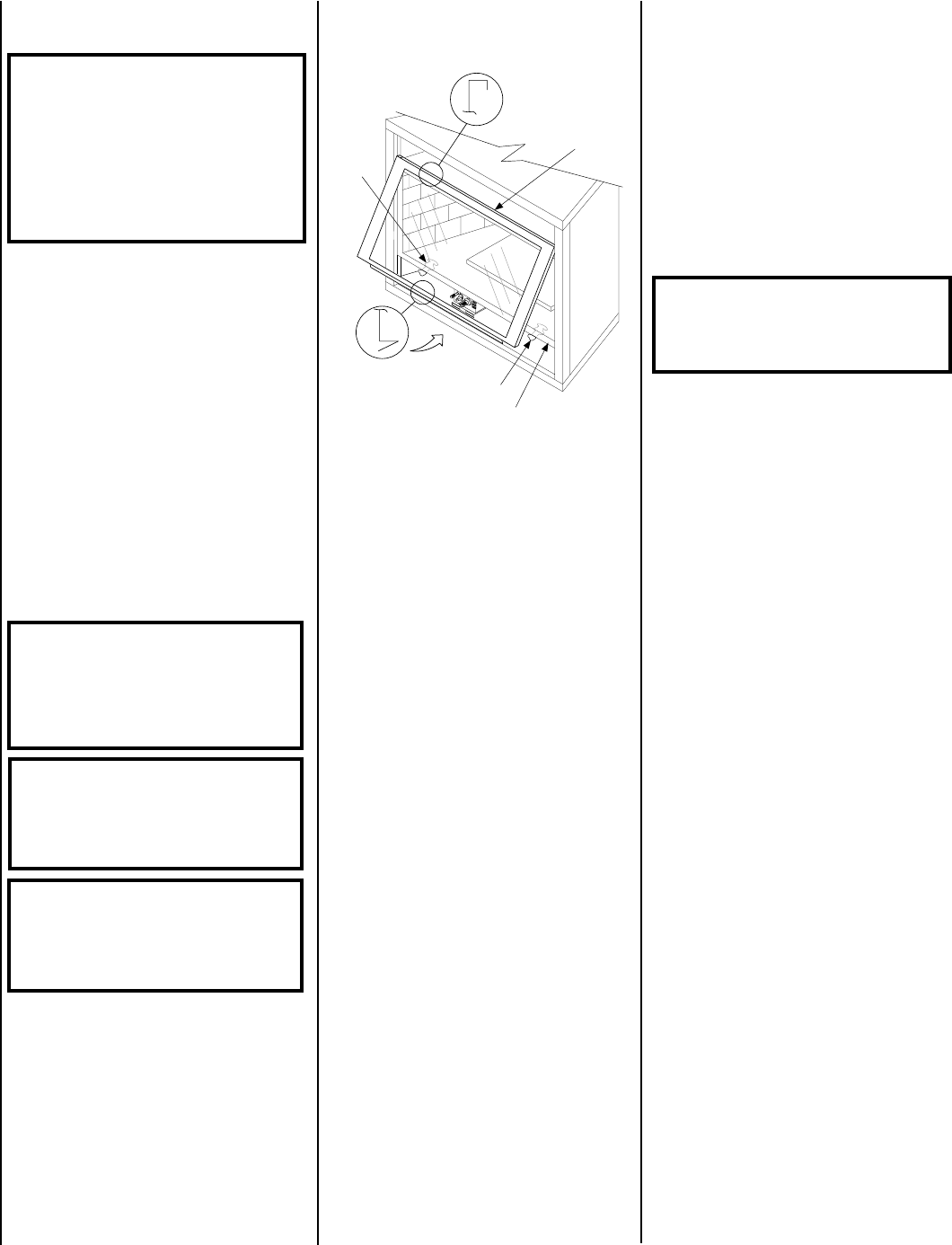
6
NOTE: DIAGRAMS & ILLUSTRATIONS NOT TO SCALE.
Front Glass Enclosure Panel, Removal
and Installation.
ENSURE THAT THE FRONT GLASS PANEL IS IN
PLACE AND SEALED DURING ADJUSTMENT.
Adjustment
CAUTION: THE ADJUSTMENT ROD AND
NEARBY APPLIANCE SURFACES ARE HOT.
EXERCISE CAUTION TO AVOID INJURY WHILE
ADJUSTING FLAME APPEARANCE.
To adjust the flame, move the adjustment rod
(located in the lower control area) up or down
to increase or reduce the air shutter opening,
respectively. Initially, always position the air
shutter to the factory setting (the minimum air
opening position) as shown in
Figure 6 on
page 7
. This can be done by pulling the adjust-
ment rod all the way down. Allow the burner to
operate for at least 15 minutes. Observe the
flame continuously. If it appears weak or sooty
as previously described, adjust the air shutter
by pushing or pulling on the adjustment rod
until the flame appearance is as desired.
The adjustment rod and associated adjustable
air shutter is patented technology. Flame ad-
justments can be made quickly and accurately
to taste without the need of disassembling the
appliance and waiting for 30 minutes after each
adjustment.
Propane models may exhibit a flame pattern
that may candle or appear stringy. If this is
problematic or persists as the appliance is
continually operated, adjust the air shutter
closed as described in the previous paragraphs.
Operate the appliance for a period of time as the
effect diminishes, ensuring that the appliance
does not develop sooty flames.
When satisfied that the appliance operates prop-
erly, proceed to finish the installation. Leave the
control knob in “ON” position and turn the
remote switch “OFF.” Close the lower control
compartment door.
To install the front glass enclosure panel,
proceed as follows:
1. Retrieve the glass door frame. Visually
inspect the gasket on the backside of the
panel. The gasket surface must be clean, free
of irregularities and seated firmly.
2. Position the door frame in front of the
firebox opening and engage the top flange
over the lip at the top of the firebox opening.
3. Swing the door down and back. Ensure the
gasket seats evenly as the door draws shut.
Engage the Vee-flange at the bottom of the
door with the latches and close the latches to
secure the door.
4. Reinstall the top louver assembly or radiant
panel.
Burner Adjustments
The following paragraphs address burner ad-
justment concerns and procedures.
Sooting is caused by incomplete combustion in
the flames and a lack of combustion air entering
the air shutter opening. To achieve a warm
yellow to orange flame with an orange body that
does not soot, the shutter opening must be
adjusted between these two extremes. No smoke
or soot should be present. Reposition the logs if
the flames impinge on any of them.
If the logs are properly positioned and sooting
conditions exist, the air shutter opening on the
main burner tube should be adjusted. Normally,
the more offsets in the vent system, the greater
the need for the air shutter to be opened further.
WARNING: NEVER OPERATE THE APPLIANCE
WITHOUT THE GLASS ENCLOSURE PANEL IN
PLACE AND SECURE. DO NOT OPERATE AP-
PLIANCE WITH THE FRONT GLASS PANEL
CRACKED, BROKEN OR MISSING. REPLACE-
MENT PANELS ARE AVAILABLE THROUGH
YOUR LOCAL LENNOX DEALER AND MUST BE
INSTALLED BY A LICENSED OR QUALIFIED
SERVICE TECHNICIAN.
These are direct-vent appliances. They are
designed to operate only with the front glass
enclosure panel properly installed. Gener-
ally, the glass enclosure panel should not be
removed except to gain access to the com-
ponents within the firebox, and the appli-
ance may only be operated without the front
glass enclosure panel in place for very brief
periods of time during initial appliance check-
out and adjustment.
During this appliance checkout and adjust-
ment period, a potential safety hazard exists
- EXERCISE EXTREME CAUTION to prevent
the occurrence of any burn injuries from the
exposed flames or hot surfaces. Also note,
that while the front glass enclosure panel is
removed, the flame appearance will appear to
be smaller than normal.
WARNING: NO NOT ATTEMPT TO SUBSTITUTE
THE MATERIALS USED ON THIS DOOR, OR
REPLACE CRACKED OR BROKEN GLASS WITH
ANY MATERIALS OTHER THAN THOSE PRO-
VIDED BY THE APPLIANCE MANUFACTURER.
THE GLASS DOOR OF THIS APPLIANCE MUST
ONLY BE REPLACED AS A COMPLETE UNIT
AS PROVIDED BY THE MANUFACTURER. DO
NOT ATTEMPT TO REPLACE BROKEN,
CRACKED OR CHIPPED GLASS SEPARATELY.
WARNING: AIR SHUTTER ADJUSTMENT
SHOULD ONLY BE PERFORMED BY A
QUALIFIED PROFESSIONAL SERVICE
TECHNICIAN.
Refer to
Figure 5
and remove the front glass
enclosure panel as follows:
1. Remove the top louver assembly or radiant
panel.
2. Open the hinged drop-down control com-
partment access panel.
3. Locate the two (2) latches at the top of the
control compartment and disengage them
from the door frame's bottom Vee-flange,
pulling down on their handles to open them.
WARNING: HANDLE THE GLASS WITH EX-
TREME CARE! TEMPERED GLASS IS SUS-
CEPTIBLE TO DAMAGE (SCRATCHES, FOR
EXAMPLE) – HANDLE GLASS DOOR (GLASS
ENCLOSURE PANEL) GENTLY WHILE RE-
INSTALLING IT.
4. Swing the bottom of the door out and raise
it slightly to lift the top flange of the door frame
away from the appliance.
Figure 5
Flame Appearance and Sooting
Proper flame appearance is a matter of taste.
Generally most people prefer the warm glow of
a yellow to orange flame. Appliances operated
with air shutter openings that are too large will
exhibit flames that are blue and transparent.
These weak, blue and transparent flames are
termed anemic. If the air shutter opening is too
small sooting may develop.
Sooting is indicated by black puffs developing
at the tips of very long orange flames. Sooting
results in black deposits forming on the logs,
appliance inside surfaces and on exterior sur-
faces adjacent to the vent termination.
Latch
Latch
Glass Door
Firebox Floor
Bottom Vee-flange
Door Frame
Top Flange
Door Frame



